by Jim Lobe
Just 11 days before the annual policy conference of the American Israel Public Affairs Committee (AIPAC), the embattled organization got some more bad news, this time in the form of a Gallup poll suggesting that nearly ten years of effort in demonizing Iran in the U.S. public mind may be going down the drain. As Gallup noted in the lede on its analysis of the poll, “Half as many Americans view Iran as the United States’ greatest enemy today as did two years ago.”
Indeed, for the first time since 2006, according to the survey of of more than 1,000 U.S. adults, Iran is no longer considered by the U.S. public to be “the United States’ greatest enemy today.” The relative threat posed by Iran has fallen quite dramatically in just the last two years, the survey found. In 2012, an all-time high of 32 percent of respondents identified Iran as Washington’s greatest foe, significantly higher than the 22 percent who named China. Beijing has now replaced Tehran as the most frequently mentioned greatest threat.” Twenty percent of all respondents cited China, while only 16 percent — or half the percentage of respondents compared to just two years ago — named Iran (which was tied with North Korea).
This is a significant setback for the Israel lobby and AIPAC, which has made Iran the centerpiece of its lobbying activities for the past decade and more, and it should add to the consternation that many of its biggest donors (as well as members) must feel in the wake of its serial defeats on Chuck Hagel, Syria, and, most importantly, on getting new sanctions legislation against Iran last month. As its former top lobbyist, Douglas Bloomfield told me three weeks ago,
Like the old cliche about real estate, ‘Location, location, location,’ for [AIPAC], it’s been ‘Iran, Iran, Iran. Israel and the peace process is in a distant second place.
Now, of course, just as one swallow does not a summer make, one poll can’t be seen as showing a definite trend. But, as you can see from Gallup’s 2001-2014 tracking graph below, the decline in threat perception since 2012 has been remarkably sharp compared, for example, to China’s showing, which has been relatively stable. And the difference between the two nations — 20 percent versus 16 percent — is within the 4-percent margin of error. Still, the fact (brutal as it is for AIPAC) remains: Iran, while still very unpopular (only 12 percent of respondents have a favorable image of it, second in unfavorability only to North Korea), is no longer seen by an important percentage of the population as Washington’s “greatest enemy.”
Moreover, as noted by Gallup’s analysis, “[g]roups that were the most likely to view Iran as the top enemy, such as men, older Americans, and college graduates, tend to show the greatest declines” in seeing Iran as Public Enemy Number One. Younger respondents (aged 18 to 34 years) were least likely to see Iran as the greatest enemy; only nine percent, compared to 21 and 20 percent for China and North Korea, respectively. As for party affiliation, a plurality of Republicans — the party most influenced by neoconservative ideology — still see Iran as the most threatening (20 percent, versus China’s 19 percent); while 23 percent of independents named China as the greatest enemy compared to 16 percent who selected Iran. Among Democrats, 24 percent cited North Korea; only half that percentage named Iran.
Clearly, President Hassan Rouhani and his Foreign Minister Javad Zarif, who dominated U.S. news coverage of Iran during their New York visit in September, as well as progress in negotiations over Iran’s nuclear program, have made a big difference, thus vindicating Benjamin Netanyahu’s (and AIPAC’s) worst fears. No doubt growing tensions between China and its neighbors have also drawn attention away from Iran (which should help, in a somewhat perverse way, Obama’s efforts to “pivot” foreign policy resources more toward Asia), although, as noted above, concern about China has remained relatively stable over the 13 years and actually declined slightly compared to 2012.
Of course, this could also turn around in a flash given the right catalyst. A breakdown in the talks, an incident at sea, or some other unanticipated event could persuade the public that all of the rhetoric about how Iran poses the greatest threat imaginable to the United States and its allies — likely to be amplified at the Washington Convention Center, where AIPAC holds its conference early next month — could propel Tehran back up to the top of the enemies list. But, for now, it’s clear that Netanyahu, who is expected to continue — if not escalate — his aggressive denunciations against the nuclear deal and U.S.-Iranian detente when he comes here to keynote the AIPAC conference, faces a tougher challenge in persuading the American public that Iran poses the greatest threat to U.S. security than at any time since he became Prime Minister. For more on Bibi’s challenges here, read J.J. Goldberg’s editorial in the latest Forward entitled, “Benjamin Netanyahu Tells AIPAC to Put Its Head in a Noose: Pushing American Jews to Take Unpopular Stand on Iran.”
Photo: US Secretary of State John Kerry, EU Foreign Policy Chief Catherine Ashton and Iran’s Foreign Minister Mohammad Javad Zarif seated beside each other during a ministerial meeting on the sidelines of the UNGA on Sept. 26, 2013.

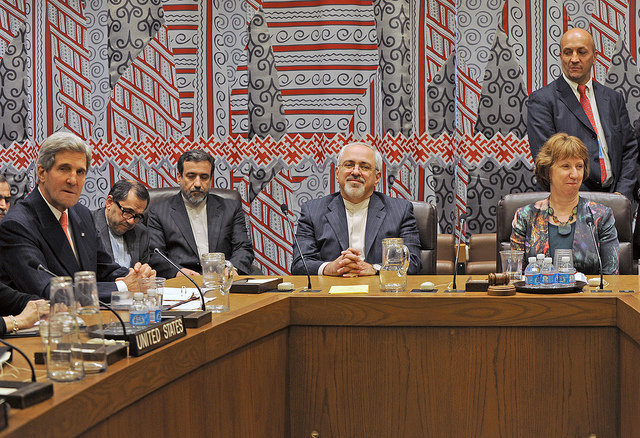
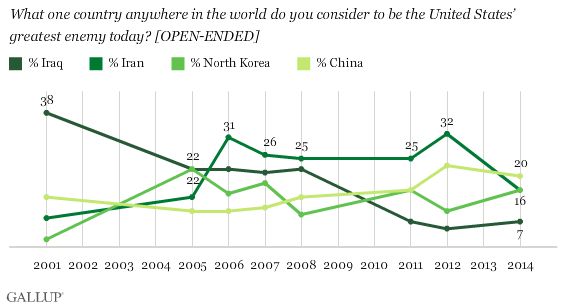
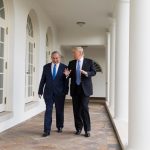

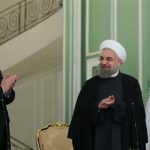
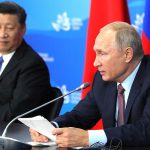
Ironically, there has been no greater subversive force undermining the basic, foundational principles of this Republic than AIPAC. AIPAC has functioned as Israel’s ‘Fifth Column” and should be treated as such.
For me, the countries that are the greatest threat to World peace are Israel itself, followed closely by the USA. If any responses reflected those countries in that light, I am very sure those responses were “removed for clarity”. It is impossible to get an accurate and fair poll if the publishers won’t accept the results. The level of corruption is deep indeed.
If the American public were even half way informed, they’d know that their number one enemy is Israel, along with thousands of dual-loyalist Zionist who hold positions of power and influence in this country..
Today’s New York OpEd, 2-22-14, carried an article by AIPAC leadership promoting, once more the increased pressure to be placed on Iran via additional sanctions. This is despite the fact that the Menendez-Kirk proposal actually exceeds the NPT format that the talks with Iran are based upon, and will more than likely scuttle the talks should there be implementation. The significant question to ask at this juncture and to find the answer seems to me to be confluence of US national interests and that of state of Israel. And should the answer be that US foreign policy in the Middle East is run from Washington, DC, and not Tel Aviv, then, the leadership team in DC needs to be very clear on that with Tel Aviv. As such, US should not then fight yet another war for state of Israel in that region, this time with Iran. A peaceful resolution that all parties to the negotiations could live with “happily” would be far better than the ugly alternative.
This is shocking. China and North Korea are #1 threats. You’d think Justin Beiber would be right up there. Nothing more dangerous than a 19 year-old with plenty of money who doesn’t give a #%&*.
What about Israeli public opinion? I was reading Israeli opinion polls in recent years ranking the top ten threats to Israel put Iran at eight or nine, near the bottom. It seems this “Iran threat” is a lot of hot air mostly on this side of the Atlantic.